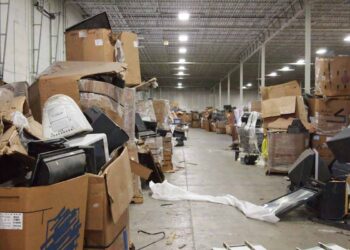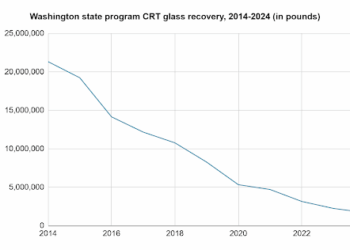Com2 Recycling Solutions says a new production line has been installed at its expanded Carol Stream, Illinois headquarters to use both panel and funnel CRT glass as a flux and lead oxide to make ceramic tiles.
“With glass-to-glass and smelting options shrinking, we knew we had to figure out a way to economically recover the glass ourselves,” Com2’s CEO Saheem Baloch said in a release earlier this month.
The company, which has processed e-scrap for a number of years, says its CRT pricing “is expected to be quite competitive with other options” and claims it will be able to process 15,000 tons of CRT glass each year. Production will start either in late October or early November, said the company’s vice president of sales and marketing, Mark Medic. Testing has shown the tiles “pass the hazardous waste test for all substances,” according to the company.
Medic noted that there are “serious limitations” when it comes to current outlets for U.S. glass, a situation that is expected to worsen if Videocon, the lone glass-to-glass recycling option, discontinues processing glass as some in the industry have speculated.
Com2 had been sending glass downstream to Videocon, but began developing its own process once it became clear the firm “wasn’t going to be in the CRT business much longer,” Medic said.
The announcement comes on the heels of the U.S. EPA’s approval of the tile manufacture process, which is also being employed in Spain through Camacho Recycling, as “legitimate recycling.” While noting that states had the authority to issue more stringent policies, the federal stance is expected to trickle down to local governments attempting to handle the CRT-dominant consumer electronics waste stream.
Com2’s Carol Stream facility is certified to the R2:2008 standard, according to the certification website. The company’s Mississauga, Ontario facility is certified to both R2 and e-Stewards.
Com2’s emergence in the CRT recycling field comes as the space continues to expand. Com2’s Illinois competitor Kuusakoski U.S. is working with a landfill to turn glass into alternative daily cover – a process the federal EPA, many states and both certification standards deem disposal, not recycling – while Nulife Glass and Closed Loop Refining and Recovery are taking on glass feedstock in preparation to run CRT glass smelting operations. Another company, newcomer Recovered Energy, has plans to process glass using plasma processing at sites in Idaho and Florida.
Com2 says it was able to secure financing from a bank for the $1.2 million to $1.5 million project.























